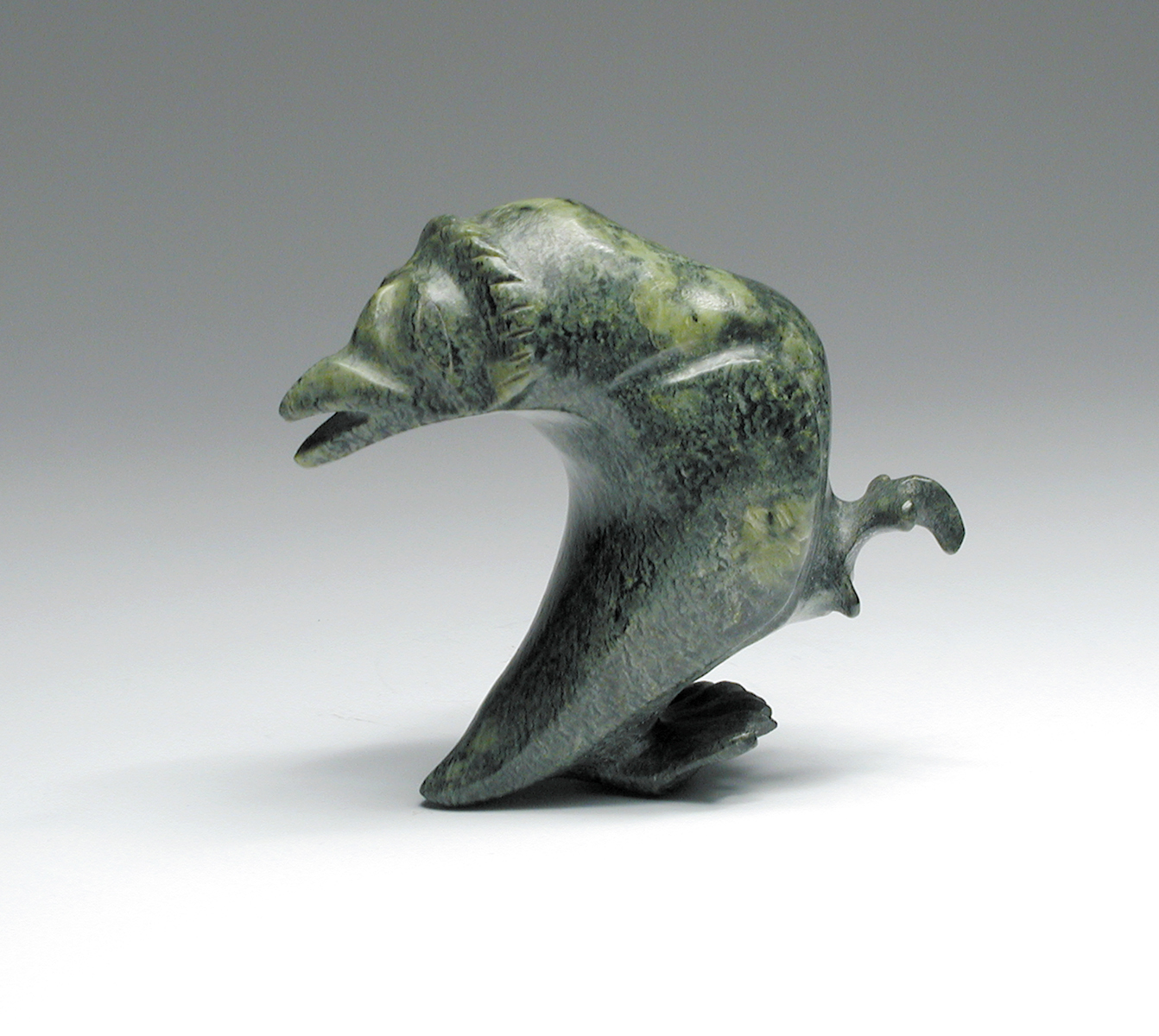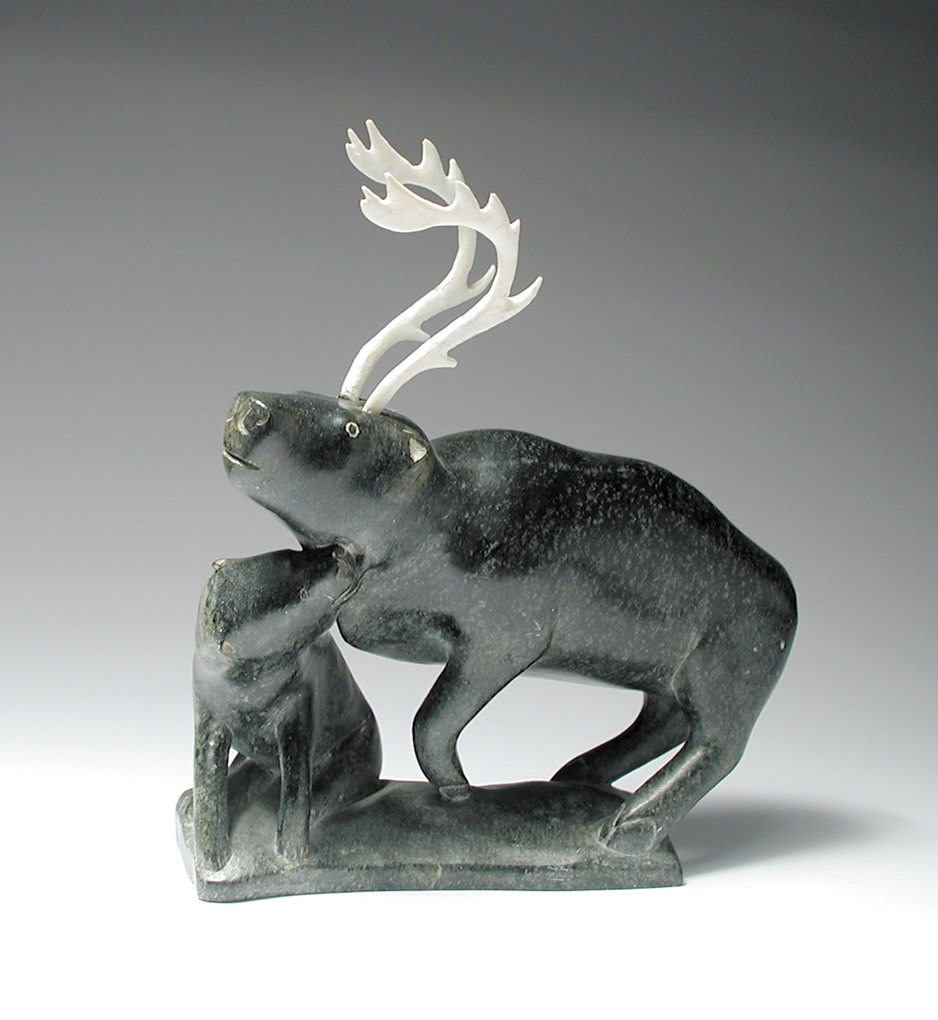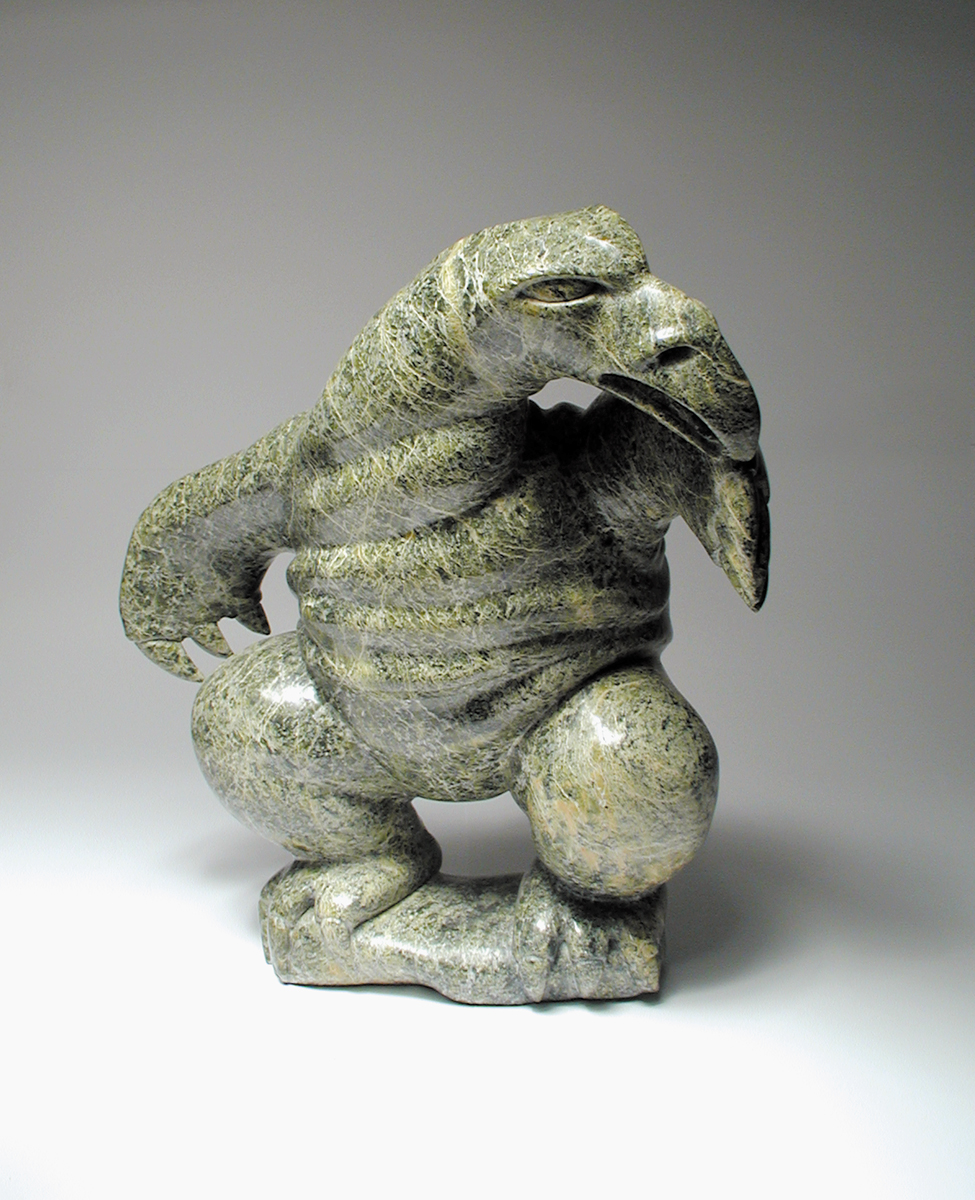
Eegyvudluk Pootoogook, FANTASTIC BIRD, Cape Dorset, ca. 1964, stone, 4 x 2 x 4 in.
Exhibition opened June 1, 2002
The Art of Collecting
Over the past decade, Feheley Fine Arts has been proud to feature several exhibitions of Inuit art from significant private collections, including the Klamer Family, Jack Butler and Sheila Butler, and Terry Ryan. However — for a multitude of personal reasons — sometimes collectors prefer to remain anonymous. While we work diligently to ensure correct provenance in such instances, we are equally careful to respect the privacy of these individuals. This exhibition gives us the opportunity to feature treasures which have recently come to us from such ‘discreet’ collectors. As well, it provides an insight into the world of the private collector through the eyes of one man who has dedicated much of his life to assembling a superb group of works.
A collector with a great eye, M.F. (“Budd”) Feheley, agreed to sit down with Michelle Lewin in May 2002 to reflect upon his experience as collector. This exhibition features a release of works from his extensive private collection of Inuit art.
This exhibition also provides us with the opportunity to address questions often asked by those who wish to acquire a great collection of Inuit art. Of course, an art collection is as individual as a thumbprint and there is no simple checklist to follow! Some collections happen quickly, while others grow surprisingly over time. Some are comprehensive, while others feature one subject, artist or region. It is relatively easy to look back with hindsight and see the road travelled, but the journey is almost inevitably random, with many subtle directional shifts over the years.
Each collector’s story is unique. An art collection begins with a single object that says to you: “take me home.” Individual pieces often serve as touchstones for memory as collectors recall the moment they saw that first artwork or the excitement of the exhibition that swept them up in the ’red dot rush’ to purchase a special treasure. Once a passion has been sparked, a research phase often follows, filled with reading, looking, and discussion with others who share this interest. Developing a relationship with a reputable gallery ensures you will know about quality artworks as they become available. Some collectors are inspired to travel to the source of the art to better understand the artists’ motivation and environment. Some collectors even proceed to become patrons of the arts through generous donations to public collections, or the sponsorship of specific artist projects.

Pauta Saila, DANCING BEAR, Cape Dorset, 1976, stone, 8 x 5.5 x 4 in.
Once a collection has grown to a considerable size, research at evaluation by a professional in the field can be beneficial in order to document the works. Today, computer software increasingly enables collectors to track subsequent acquisitions themselves, quickly and concisely. At a glance, you can review the extent of your selections to dates, often triggering new avenues of pursuit, or helping to confirm enthusiasm for a particular artist, subject or style.
Ultimately, there is no real ‘rhyme or reason’ – an art collection is a pure reflection of an individual collector. Or, when the artworks have been selected by two or more people the characteristics of the collection seem to resonate between the personalities, increasing its complexity almost like the voices in an Inuit throat song. For collectors, the joy is in the searching, the finding and the sheltering of special objects selected by hand from amongst all others. Our conversation with collector Budd Feheley confirms this special pleasure beginning with a reminiscence about his first ’find’.
The Consummate Collector: M.F. Feheley
For Budd Feheley, it all began at an exhibition — one of the first public sales of Inuit art at the Canadian Handicrafts Guild in Montreal. “I was walking Peel Street on my way to an eleven o’clock meeting at an advertising agency,” he recalls, “and I saw a line-up at the gallery across the road. I thought, that’s strange, at this time in the morning. So, not knowing what it was, I went and got in line, and when I got inside the door they were selling Eskimo art. They handed me a little basket, which I couldn’t figure out. I put six sculptures in it — they were going for 10 to 25 dollars each. When I got to the cashier I wasn’t allowed to buy all six because they wanted enough for everybody, so I put some back. Needless to say, I was late for my appointment.”
This was the ‘eureka’ moment, from which grew a life-time love affair with Inuit art and the Arctic. Immediately, Budd Feheley was inspired to travel north to see, firsthand, the source of this wonderful new work. “I caught a cargo plane to Puvirnituq. We sat on crates, and the toilet on the plane was an oil drum. Don’t think about it!,” he jokes. On that first night, he arranged to sleep in a settlement church in exchange for assisting the priest. “I knew no one; didn’t know the language. Later I got on a cargo plane and caught a ride to Dorset.” Budd recalls that he came home with many “bits” from that trip (the first of many), and for him the die was cast.

Thomassiapik Sivuarapik, CARIBOU AND WOLF, Puvirnituq, 1962, stone & antler, 8 x 6 x 3.5 in.
Inuit art became a passion for Budd Feheley. He became a founding member of the Canadian Eskimo Arts Council, and assisted the Toronto-Dominion Bank in the development of their significant collection of Inuit art. He donated treasures to public museums such as the National Gallery of Canada from his personal collection.
In addition to being a collector, he became a private dealer in Inuit art, finally opening in Toronto as a ‘by-appointment-only’ gallery. “Mostly my friends came in!” he recalls. Eventually, the gallery opened to the broader public. With his warm welcome and engaging personality, Budd has introduced countless visitors to the joy of collecting Inuit art.
Through his numerous trips North, he became a mentor to many of the great contemporary Inuit artists he met in the Arctic settlements. Equally, his hospitality and generosity greeted the artists when they ventured South for exhibition openings and art world events, ensuring life-long friendships that continue to this day.
In addition to championing Inuit art, Budd has worn innumerable other hats. Trained as a commercial artist, in 1946 he co-founded the hugely-successful commercial art studio, TDF Artists Limited. TDF was acclaimed for its achievements in graphic art, photography and film, and many Canadian contemporary artists such as Jack Bush, worked there over the years. Budd co-founded The Park Gallery in the late 1950s, a private Toronto gallery exhibiting avant-garde Canadian and European artists. “I met so many great artists,” he recalls simply. “I was a personal friend of Henry Moore. We visited each other’s homes. During his visits to Drumsnab[1], he particularly admired my collection of Inuit art.” Budd’s personal collections ranged from Inuit sculpture to Impressionist drawings to early Canadian furniture and contemporary American prints.
Budd retired from the gallery business in 1991, but has maintained an enduring interest Inuit art. Many of the works he has kept in his private collection are small-scale carvings from the mid-twentieth century, at the cusp of the contemporary period of Inuit art. These ’little treasures’ speak to him of a special moment in time. “It wasn’t because they were cheap, it was because I liked them,” he explains. “At one time they made them very small. The old timers would pick up piece of bone on the beach somewhere, or a walrus tusk that was hollow. I think these are delightful little pieces.”

Kiawak Ashoona, SPIRIT FIGURE, Cape Dorset, stone, 18 x 14.5 x 14.5 in.
Budd traces his great interest in art to an academic background in visual art at Western Technical Secondary School in Toronto. “I studied under L.A.C Panton, the greatest Canadian artist that ever lived,” Feheley explains. When asked if this is how he developed his collector’s eye, he muses, “Either you’re born with it, or you have a certain tendency. … I think the fact that I was some kind of an artist, and studied art, helps a hell of a lot.”
When asked if he has always been a collector at heart, Budd answers emphatically, “Yes, I still am! …You just see something and think, my god, I’d love to own that — have it for a while.” He is decisive about the process of choosing a work of art: “It’s seeing something and knowing you’d love to live with it. Often, I might like one thing but I don’t want to live with it. Then I don’t buy it … but can continue to admire it. Even a piece that isn’t successful, you think about. Why did the artist try to do it? What could he have done to make it — well, more attractive to me, anyway!”
What does Budd think of the common refrain that Inuit art has all ended in museums or become derivative or prohibitively expensive? “Oh, it’s still around, but you’ve got to be very selective,” he advises. “They’re still here. There are pieces being sold today that I wouldn’t mind having!” he adds, with a twinkle in his eye. Budd still finds himself searching out treasures in his travels, pointing out that, “I’ve always had to acquire things.” His next scheduled trip is to Alaska. “I’ll just keep my eyes open”.
Some collectors focus on a particular artist or subject, while others acquire a broad selection of art that runs the gamut from the traditional to the ultra modern. Budd Feheley has experienced both ends of the spectrum in his ‹ collecting. At times, he gravitated toward sculpture by Osuitok or graphic Kiakshuk or Parr, but overall there are few simple threads to be traced thru his large collection. If anything, his selections indicate an early interest in original drawings. “I liked them and it was easier to buy in those days up there. There was nobody really after them, yet.” In the drawings we glimpse the spark – the original idea – that can identify a great, or soon-to-be-great, artist. “Drawing is the essence of art, ” Budd asserts.
Much of Budd Feheley’s enthusiasm for collecting reflects the experience of others and can, to some degree, speak for those who prefer to remain anonymous. The works over these and the next two pages come from another private collection. The collector’s discerning eye extended far beyond the bounds of Inuit art to include American quilts and basketry as well as Inuit and North West Coast treasures.
The world of Inuit art enthusiasts is still a relatively small community. As a result, works can and do return to the secondary market on a regular basis. Early treasures from private Canadian and International collections occasionally return to the public eye, like proud children who do not wish to sit quietly in the background. This exhibition includes a handful of works which have resided in more than one private collection over the past decade. We recognize with pleasure ’old friends’ that re-emerge here, to the joy of established and emerging collectors alike!
[1] Drumsnab is a previous Toronto residence of M.F. Feheley. He had the historically-significant home meticulously restored to mid-nineteenth century period. Today, Drumsnab is remembered as the staging ground for Feheley’s museum-quality collections of art and furniture viewed by many Torontonians during regular ‘open house’ days.
